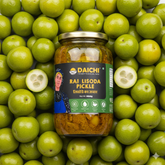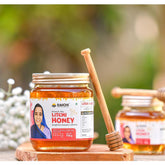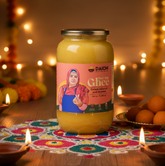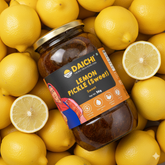If you grew up in an Indian household, you may recall this: a warm roti smeared with ghee, a gentle golden drizzle melting over dal, or your mother exclaiming, "Thoda aur daal du?" before you could respond. Ghee was never just a choice in our homes. It was a tradition we grew up with.
But in between "low-fat diets" and "refined oil revolutions," ghee became misunderstood — until science finally caught up with what our grandmothers always knew.
Ghee is not a bad fat. It is in fact good for health.
Still, if you've just been through a supermarket or browsed through items online, you've definitely seen dozens of options — A2 Ghee, Bilona Ghee, Cow Ghee, Buffalo Ghee, Organic Ghee, and others. So, which is the best option for your health??
Let's simplify this for you.
1. Cow Ghee — A Kitchen Staple
Most Indian households consume cow ghee on a daily basis. Cow ghee, which is made from cow's milk, is lighter, more fragrant, and golden yellow compared to buffalo ghee. It contains Omega-3 fatty acids as well as vitamins A, D, E, and K, all of which promote heart health and immunity.
Cow ghee is particularly beneficial to youngsters and the elderly due to its easy digestibility. When prepared traditionally — using the Bilona method and milk from indigenous cow breeds — the result is a nutrient-dense, gut-friendly A2 Bilona ghee.
If you’re looking for the best desi ghee in India for your daily needs, choose A2 cow ghee prepared using the traditional Bilona method — it’s likely to be the most authentic choice.
2. Buffalo Ghee: Thick and Creamy
Buffalo ghee is whiter, thicker, and has a more concentrated scent. It's produced with buffalo milk, which is more fat and protein than cow milk. While it is highly nutritious and energy-dense, it is also more difficult to digest, making it better suitable for the winter or for persons who require a large calorie intake. In Ayurveda, buffalo ghee is frequently advised for bodybuilders or those seeking strength-building fats, whereas cow ghee is preferred for daily nourishment and balance.
So, while cow ghee has health benefits, it's not recommended for regular consumption, especially if you lead a sedentary lifestyle.
3. Bilona Ghee: The Ancient and Better Way
This is where purity meets patience. The Bilona technique is a traditional Indian method of manufacturing ghee using curd rather than cream.
This is how it works:
-
Curd is made from fresh milk, ideally from Desi cows.
-
The curd is hand-churned with a wooden bilona to separate butter.
-
The butter is then slowly cooked over low heat to produce beautiful, aromatic ghee.
What was the result? A nutrient-dense, easily digestible ghee that keeps its natural butyric acid, Omega fats, and vitamins. This is the kind of ghee that Ayurveda recommends: pure, sattvic, and nourishing for all body types. When buying desi ghee online, opt for Bilona ghee, which improves digestion, energy, complexion, and hormonal balance.
4. A2 Ghee — The Modern Name for Ancient Purity
You've certainly seen the word "A2 Ghee" everywhere, but what exactly does it mean?
Simply defined, A2 milk is derived from Indian cow breeds such as Gir, Sahiwal, Tharparkar, and Rathi, which provide milk that contains solely the A2 beta-casein protein. This makes it easier to digest and similar in structure to human milk.
A2 Ghee, manufactured utilizing the Bilona process, is regarded as the purest and most healthy type of ghee available today.
It supports:
-
Gut Health and Immunity
-
Joint Strength and Flexibility
-
Radiant skin and healthy hair growth
-
Heart and hormonal balance
When you see organic A2 Bilona ghee online, it indicates it's created from Indian cow milk with no hormones, additives, or high-heat processing — essentially, the same ghee your grandma used to make, but now available again.
5. Organic Ghee: Clean, Safe, and Traceable
With so many contaminated food items on the market, the label organic is more important than ever. Organic desi ghee is made from grass-fed cows that have not received synthetic feed, antibiotics, or hormones. This guarantees that the ghee is toxin-free and rich in natural fatty acids and antioxidants.
When purchasing organic desi ghee online, seek for small-batch manufacturers that specify the source of their milk and the procedure; if it's hand-churned, curd-based, and made from A2 milk, you've discovered the real thing.
6. Clarified Butter (Western Ghee)—Not Quite the Same
Many Western recipes use the term "ghee" to refer to clarified butter, which is not the same thing. Clarified butter is created by boiling butter to remove milk particles, but it does not include the fermentation process that gives Indian Bilona ghee its distinct health benefits.
So, while clarified butter is useful for cooking, it lacks the richness, aroma, and gut-healing benefits of desi cow ghee.
If you want better digestion, long-term wellness, and pure vitality, A2 Bilona Ghee prepared from desi cow milk is the ideal option. It's light, nutrient-dense, and has roots in both Ayurveda and Western nutrition. Unlike refined oils or manufactured ghee, it not only contributes flavor, but also balance.
Choosing the Right Ghee Online
When purchasing desi ghee online, check for these markers of purity:
-
Made from curd, not cream
-
Hand-churned (Bilona method)
-
From Indian desi cows (A2 milk)
-
Grainy texture and nutty aroma
-
No added color, flavor, or preservatives
And if it comes from a company that favors handmade craftsmanship over machines, all the better. Because that indicates the folks behind it still believe in slow food, which not only fills you up but also grounds you. All ghee may have the same appearance – golden, smooth, and inviting. But the distinction is in the story it tells. The best desi ghee in India is not the one with the flashiest packaging or imported promises. It's the one constructed with time, care, and the appropriate hands—the one your body recognizes as home.
So, when you pour ghee over warm rice or dal tonight, make sure it knows where it came from.









